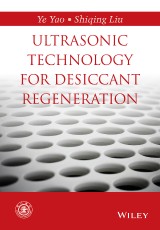Details
Ultrasonic Technology for Desiccant Regeneration
1. Aufl.
|
123,99 € |
|
| Verlag: | Wiley |
| Format: | EPUB |
| Veröffentl.: | 25.08.2014 |
| ISBN/EAN: | 9781118921630 |
| Sprache: | englisch |
| Anzahl Seiten: | 336 |
DRM-geschütztes eBook, Sie benötigen z.B. Adobe Digital Editions und eine Adobe ID zum Lesen.
Beschreibungen
The chapters in this volume explore ultrasound-assisted regeneration of silica gel, ultrasound-assisted regeneration for a new honeycomb desiccant material, ultrasound-atomizing regeneration for liquid desiccants, ultrasonic transducers, and much more.
<p>About the Authors ix</p> <p>Preface xi</p> <p>Acknowledgements xiii</p> <p>Nomenclature xv</p> <p><b>1 Introduction 1</b></p> <p>1.1 Background 1</p> <p>1.2 Literature Reviews 2</p> <p>1.2.1 Desiccant Materials 2</p> <p>1.2.2 Types of Desiccant Dryer 4</p> <p>1.2.3 Regeneration Methods 10</p> <p>1.3 The Proposed Method 19</p> <p>1.3.1 Basic Knowledge about Ultrasound 19</p> <p>1.3.2 Sound Generation 22</p> <p>1.3.3 Fundamental Theory for Ultrasound-Assisted Regeneration 24</p> <p>1.4 Summary 26</p> <p>References 26</p> <p><b>2 Ultrasound-Assisted Regeneration of Silica Gel 33</b></p> <p>2.1 Theoretical Analysis 33</p> <p>2.2 Experimental Study 38</p> <p>2.2.1 Experimental Setup 38</p> <p>2.2.2 Procedure for Experiments 39</p> <p>2.2.3 Methods 40</p> <p>2.2.4 Results and Discussions 42</p> <p>2.3 Empirical Models for Ultrasound-Assisted Regeneration 51</p> <p>2.3.1 Model Overviews 51</p> <p>2.3.2 Model Analysis 52</p> <p>2.4 Theoretic Model for Ultrasound-Assisted Regeneration 59</p> <p>2.4.1 Physical Model 62</p> <p>2.4.2 Mathematical Model for Ultrasonic Wave Propagation 62</p> <p>2.4.3 Mathematical Model for Heat and Mass Transfer in Silica Gel Bed 67</p> <p>2.4.4 Model Validation 75</p> <p>2.4.5 Error Analysis for Experimental Data 85</p> <p>2.5 Parametric Study on Silica Gel Regeneration Assisted by Ultrasound 89</p> <p>2.5.1 Acoustic Pressure and Oscillation Velocity in the Packed Bed 89</p> <p>2.5.2 Thermal Characteristics of the Bed during Ultrasound-Assisted Regeneration 91</p> <p>2.5.3 Enhancement of Regeneration Assisted by Ultrasound 106</p> <p>2.5.4 Comparisons between the Transverse- and Radial-Flow Beds 110</p> <p>2.6 Quantitative Contribution of Ultrasonic Effects to Silica Gel Regeneration 110</p> <p>2.6.1 Theoretical Analysis 110</p> <p>2.6.2 Method 113</p> <p>2.6.3 Results and Discussions 114</p> <p>2.7 Energy-Saving Features of Silica Gel Regeneration Assisted by Ultrasound 119</p> <p>2.7.1 Specific Energy Consumption 119</p> <p>2.7.2 Results and Discussions 120</p> <p>2.7.3 Brief Summary 125</p> <p>2.8 Effects of Ultrasound-Assisted Regeneration on Desiccant System Performance 126</p> <p>2.8.1 Study Objective and Method 126</p> <p>2.8.2 Results and Discussions 127</p> <p>2.8.3 Brief Summary 139</p> <p>References 139</p> <p><b>3 Ultrasound-Assisted Regeneration for a New Honeycomb Desiccant Material 141</b></p> <p>3.1 Brief Introduction 141</p> <p>3.2 Experimental Study 142</p> <p>3.2.1 Experimental System 142</p> <p>3.2.2 Raw Material and Experimental Conditions 142</p> <p>3.2.3 Analysis Parameters 144</p> <p>3.2.4 Experimental Results 145</p> <p>3.2.5 Energy Attenuation and Absorptivity of Ultrasound in the Material 154</p> <p>3.3 Theoretical Model for Honeycomb-Type Desiccant Regeneration 159</p> <p>3.3.1 Basic Assumptions 159</p> <p>3.3.2 Governing Equations 159</p> <p>3.3.3 Determination of Key Parameters 160</p> <p>3.3.4 Model Validation 161</p> <p>3.4 Model Simulations and Analysis 163</p> <p>3.4.1 Parametric Study 163</p> <p>3.4.2 Quantitative Contributions of Ultrasonic Effects to the Regeneration of Honeycomb-Type Desiccant 172</p> <p>3.5 Summary 176</p> <p>References 176</p> <p><b>4 Ultrasound-Atomizing Regeneration for Liquid Desiccants 177</b></p> <p>4.1 Overview 177</p> <p>4.1.1 Principles and Features of the Liquid-Desiccant Dehumidification 177</p> <p>4.1.2 Thermo-Physical Properties of Liquid Desiccant Materials 178</p> <p>4.1.3 Research Status of Solution Regenerators 182</p> <p>4.2 Theoretical Analysis 183</p> <p>4.2.1 Mass Transfer Coefficients for the Droplets 183</p> <p>4.2.2 Atomized Size of Droplet by Ultrasonic Atomizing 192</p> <p>4.2.3 Droplet Distribution Characteristics and Measurement Techniques 194</p> <p>4.2.4 Vapor Pressure of Liquid Desiccant Mixture 196</p> <p>4.3 Theoretical Modeling for the Ultrasound-Atomizing Regenerator 201</p> <p>4.3.1 Assumptions 201</p> <p>4.3.2 Basic Equations 201</p> <p>4.3.3 Determination of Key Parameters 202</p> <p>4.3.4 Model Validation 203</p> <p>4.3.5 Parametric Study 208</p> <p>4.4 Performance Analysis of Liquid-Desiccant Dehumidification System with Ultrasound-Atomizing Regeneration 221</p> <p>4.4.1 The Ultrasound-Atomizing Regenerator versus the Packed One 221</p> <p>4.4.2 Performance of Liquid Desiccant System with Different Regenerators 226</p> <p>References 233</p> <p><b>5 Ultrasonic Transducers 235</b></p> <p>5.1 Longitudinal Vibration of Sandwich Piezoelectric Ultrasonic Transducer 235</p> <p>5.1.1 Overview 235</p> <p>5.1.2 Theoretical Analysis 240</p> <p>5.1.3 State Equations of Sandwich Piezoelectric Electromechanical Transducer 248</p> <p>5.1.4 Design Case 256</p> <p>5.2 Radial Vibration Ultrasonic Transducer 258</p> <p>5.2.1 Overview 258</p> <p>5.2.2 Theoretical Analysis and Design of a Binary Radial Transducer 259</p> <p>5.2.3 Radial Vibration Sandwich Piezoelectric Transducer 267</p> <p>5.2.4 Summary 275</p> <p>5.3 Ultrasonic Atomization Transducer 275</p> <p>5.3.1 Basic Principle of Ultrasonic Atomization 275</p> <p>5.3.2 Basic Structure of Ultrasonic Atomizers 275</p> <p>5.3.3 Research Status and Applications 277</p> <p>References 281</p> <p><b>6 Desiccant System with Ultrasonic-Assisted Regeneration 283</b></p> <p>6.1 For Solid-Desiccant System 283</p> <p>6.1.1 Based on the Longitudinal Vibration Ultrasonic Transducer 283</p> <p>6.1.2 Based on the Radial Vibration Ultrasonic Transducer 284</p> <p>6.2 For Liquid-Desiccant System 287</p> <p>6.3 Future Work 289<br /><br />6.3.1 Development of Ultrasonic Transducer 289</p> <p>6.3.2 Development of Desiccant Materials Adaptive to Ultrasound-Assisted Regeneration 290</p> <p>6.3.3 Development of Demister 290</p> <p>6.3.4 Environmental Impact 290</p> <p>References 292</p> <p><b>A Basic Equations for Properties of Common Liquid Desiccants 293</b></p> <p>A.1 Lithium Chloride (LiCl) 293</p> <p>A.2 Calcium Chloride (CaCl2) 297</p> <p>A.3 Lithium Bromide (LiBr) 299</p> <p>A.4 Vapor Pressure (Pa) 302</p> <p>A.5 Specific Thermal Capacity (J/(kg⋅∘C)) 303</p> <p>A.6 Density (kg/m3) 303</p> <p>A.7 Dynamic Viscosity (Pa s) 303</p> <p>References 306</p> <p>Index 307</p>
<p>Ye Yao and Shiqing Liu are the authors of Ultrasonic Technology for Desiccant Regeneration, published by Wiley.
Diese Produkte könnten Sie auch interessieren:

Turbulent Drag Reduction by Surfactant Additives

von: Feng-Chen Li, Bo Yu, Jin-Jia Wei, Yasuo Kawaguchi

156,99 €

Turbulent Drag Reduction by Surfactant Additives

von: Feng-Chen Li, Bo Yu, Jin-Jia Wei, Yasuo Kawaguchi

156,99 €















